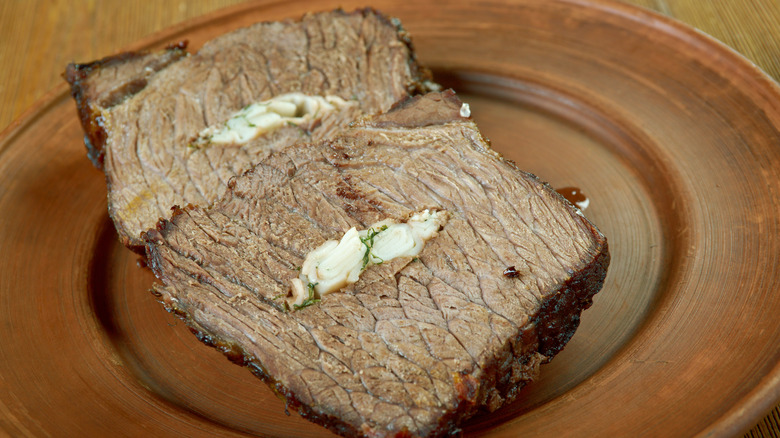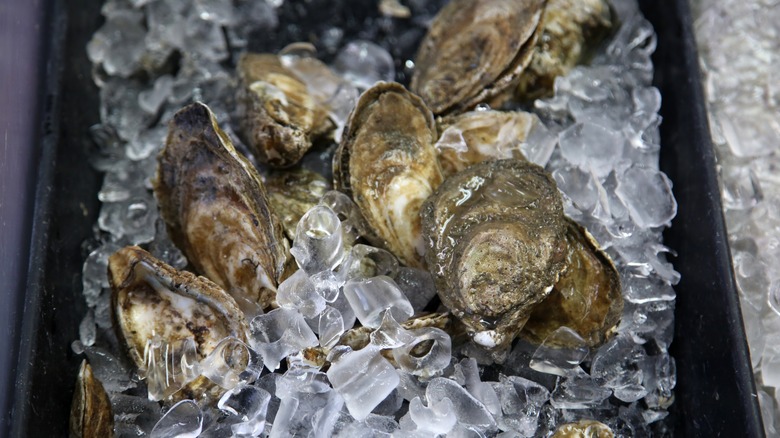Carpetbag Steak Is A Humble Dish Accompanied By Oysters
Unexpected food combinations are nothing new, and neither is our culinary desire to stuff one food inside of another. Look no further than the oft-mentioned turducken, a veritable nesting doll of fowl on fowl. But the practice stretches back and spans both land and sea, as evidenced by a dish most have likely never encountered. The carpetbag steak isn't surf and turf; it's surf in turf, a dish that sees steak partially filleted in order to create a pocket that is stuffed with oysters. As the steak cooks, its umami-laden juices intermingle with the brininess of the oysters steaming away inside.
Though it may sound like TikTok trend-worthy food, carpetbag steak has a developed history that stretches back to at least the 19th century. That said, its origins are murky, with stories of the original recipe spanning continents and speculation on its provenance given to seaside villages and haute gilded age dining halls alike.
Conceptually, carpetbag steak is a straightforward dish that leaves ample room for interpretation. No cut of beef is prescribed for the steak other than one that is cut thick enough to allow for a sturdy pocket to be carved into it. Neither is a particular type of oyster called for. Further, this carpetbag steak can be cooked however you like, from the char of the grill to the blistering heat of a high-powered broiler.
History of carpetbag steak
The origins of carpetbag steak can be traced back to a time when culinary innovation was burgeoning and adventurous palates sought novel flavor combinations. The dish itself is believed to have emerged in the United States, particularly in the coastal regions where access to fresh oysters is abundant. This is disputed, though, by a claim from the Welsh seaside village of Mumbles, famous for its oyster industry, where it is said the dish was a popular way to prepare their readily-available protein.
The name "carpetbag" refers to the travel bags that were popular during the Civil War era, often associated with opportunists who arrived in the South from the North to exploit new business prospects. This historical context adds an intriguing layer to the dish's identity, though no connection has been made between the dish's name and the derogatory term "carpetbagger."
While the precise origins are somewhat shrouded in mystery, carpetbag steak's popularity grew during the latter half of the 19th century. It became synonymous with luxury dining and was featured prominently on menus in upscale restaurants and grand hotels. The dish's appeal extended beyond its exceptional flavor; it also symbolized the fusion of regional culinary traditions, highlighting the union of hearty American beef and the bounties of the ocean.
How to make a carpetbag steak
The beauty of carpetbag steak lies in its adaptability. Various cuts of beef, as long as they are sufficiently thick, can be employed. From the luxurious tenderness of filet mignon to the robust character of ribeye, the choice represents a canvas for culinary exploration. Equally important are the oysters, which come in an array of flavors and sizes. Delicate and small oysters bring a nuanced oceanic essence, while plump and briny varieties impart a bold punch. Freshness, of course, is key.
To assemble, slice the steak partially through, forming a pocket that will cradle the oysters. Be cautious not to cut all the way through. Carefully place the chosen oysters inside the pocket, ensuring an even distribution. Season the steak and seal the pocket with a few toothpicks or a carefully threaded skewer.
Heat a skillet with butter and sear the steak until a golden-brown crust forms. Alternatively, the steak can be grilled or broiled. For further doneness, transfer the steak to the oven to complete cooking. Once finished cooking, allow the carpetbag steak a moment of repose before slicing. This interlude ensures that both the steak and oysters have time to further meld together away from the heat.


